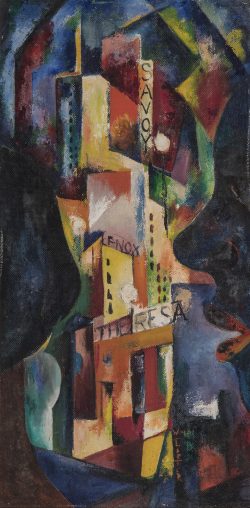William S. Carter 1909–1996
Barred from attending the racially segregated art schools in his native Missouri, African American artist William Sylvester Carter arrived in Chicago in 1930 with a scholarship to study at the School of the Art Institute of Chicago. Struggling to support himself, he attended sporadically before enrolling in the University of Illinois at Champaign-Urbana in 1935; eventually—in the 1950s—he earned both a BA and a BFA there. He also studied art at the South Side Settlement House (now Ada S. McKinley Community Services). Carter began exhibiting his work in Chicago in 1934, only slowly garnering recognition, while supporting himself with menial jobs that included serving as a janitor at the Palette and Chisel Club, an all-white artists’ organization. The cluster of federal Depression relief programs known as the WPA were a boon to Carter’s artistic career, although he began there as a laborer on the construction of a park swimming pool, among other activities. On the Illinois Art and Craft Project he helped make display dioramas for the new Museum of Science and Industry. Later hired for the Easel Division of the WPA’s Illinois Art Project, he exhibited at the WPA Gallery on Michigan Avenue; he also showed his work at the commercial Benjamin Gallery, the Hull-House settlement house, and the art show of the 1940 American Negro Exposition at the Chicago Coliseum.
Carter was part of a vibrant creative cohort present at the birth of the South Side Community Art Center in 1940; the only community art center founded in Illinois as part of a dedicated WPA program to nurture art in underserved communities, it is the only one in the nation that survives today. Supporting funds were raised at annual “artists and models balls,” for which Carter was among the artists who contributed designs for costumes, decorations, and posters. In 1940 Carter was included in Alain Locke’s book The Negro in Art, a survey of African American artists, and the following year he was represented in an important exhibition of African American art past and present held at the Downtown Gallery in New York. Further recognition followed, despite Carter’s struggles to make art while supporting himself with other work.
Using watercolor, tempera paint, oils, and ink, Carter explored a variety of styles and subjects that ranged from landscapes, figural images, and abstract compositions to the floral still-life arrangements and images of ballerinas that became his signature themes. Prolifically and perennially creative, Carter taught at the South Side Community Art Center. He also served as a substitute teacher in Chicago Public Schools, painted decorative shower curtains, did manual labor for R.R. Donnelley & Sons printing company, and worked as a porter on cross-country trains, among other jobs. In his last years, with increasing attention paid to African American art, Carter was featured in several solo and group exhibitions, while continuing to make art in his small apartment in senior-citizen public housing on Chicago’s North Side until shortly before his death.
Wendy Greenhouse, PhD
